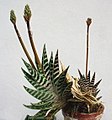 This evergreen succulent perennial is also known as tiger aloe and is a member of Asphodelaceae family that also includes daylily (Hemerocallis), red hot poker (Kniphofia), and foxtail lily (Eremurus). It is indigenous to arid and semi-arid regions of South Africa and Namibia where it grows in hard ground, rocky crevices, and between rocks as well as in some sandy soils. Plants grow up to 1′ tall and wide and form stemless rosettes of 18-24 triangular-lanceolate leaves that are 4-6″ long and 3-ranked. The leaves have small white teeth on their white horney margins and are dark green variegated by whitish spots that form irregular bands. They may take on a reddish color when water is lacking. In winter short, stout, mostly branched stems give rise to pendent flowers that are up to 18″ long and are usually orange with green edges but may be red or rarely yellow. Plants are especially drought resistant and a good choice for difficult areas where moisture is lacking. Partridge-breast is popular as a houseplant for its winter bloom but care must be taken not to over-water. The genus name, Aloe, is derived from the Arabic word alloeh meaning bitter and shiny substance and refers to the latex in the leaves. The specific epithet, variegata, is the Latin word meaning variegated and refers to the appearance of the leaves.
This evergreen succulent perennial is also known as tiger aloe and is a member of Asphodelaceae family that also includes daylily (Hemerocallis), red hot poker (Kniphofia), and foxtail lily (Eremurus). It is indigenous to arid and semi-arid regions of South Africa and Namibia where it grows in hard ground, rocky crevices, and between rocks as well as in some sandy soils. Plants grow up to 1′ tall and wide and form stemless rosettes of 18-24 triangular-lanceolate leaves that are 4-6″ long and 3-ranked. The leaves have small white teeth on their white horney margins and are dark green variegated by whitish spots that form irregular bands. They may take on a reddish color when water is lacking. In winter short, stout, mostly branched stems give rise to pendent flowers that are up to 18″ long and are usually orange with green edges but may be red or rarely yellow. Plants are especially drought resistant and a good choice for difficult areas where moisture is lacking. Partridge-breast is popular as a houseplant for its winter bloom but care must be taken not to over-water. The genus name, Aloe, is derived from the Arabic word alloeh meaning bitter and shiny substance and refers to the latex in the leaves. The specific epithet, variegata, is the Latin word meaning variegated and refers to the appearance of the leaves.
Type: Evergreen, succulent perennial
Bloom: Eighteen inch long orange to red flowers on short mostly branched stems in winter
Size: 1′ H x 1″ W
Light: Partial shade
Soil: Fertile, dry, very well-drained
Hardiness: Zones 9-11
Care: Low maintenance
Pests and Diseases: None of significance but over watering can produce root rot and death.
Propagation: Seed, division of offsets
Companion Plants: Blue chalk stick, Aeoniums, Sedums
Photo Credit: Wikipedia